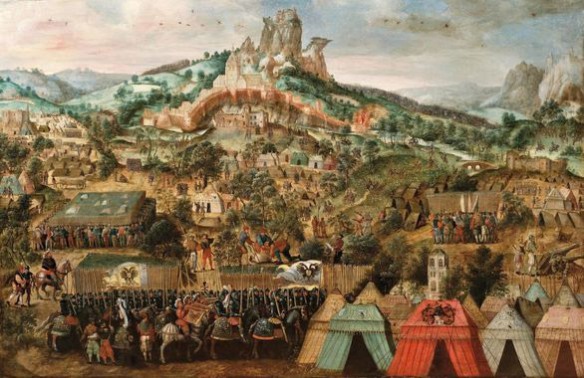The siege of Therouanne.
Henry VIII’s field and jousting armour, 1540. The size of the suit shows the king’s bulk, while the codpiece might help explain his marital problems.
When the imperial ambassador hinted in the late 1520s that Henry might not be physically capable of satisfying Anne Boleyn, a woman sixteen years his junior, the King furiously retorted, `Am I not a man like other men? Am I not? Am I not?’ The size of the codpiece on Henry’s suite of armour, suggests that Henry did protest too much.
As a young man Henry trained for war, hurling javelins, shooting arrows in the butts, wrestling in the ring and taking part in tournaments. He read all the books on chivalry, such as Sir Thomas Malory’s Morte D’Arthur, romances about the Trojan Wars and tales of Charlemagne and Roland, that poured off the recently invented printing presses. He took special delight in showing visitors to Winchester the round table around which Arthur and his knights had supposedly sat. He encouraged John Bourchier, Lord Berners, to translate Jean Froissart’s Chronicles of the Hundred Years War, because of `the great pleasure that my countrymen of England take in reading the worthy and knightly deeds of their valiant ancestors’. Henry, like many a king, was haunted by the achievements of his forebears, once admitting that he wanted to reconquer France in order to eclipse his father’s great victory at Bosworth Field.
In 1511, two years after ascending the throne, Henry sent fifteen hundred archers to Cadiz in southern Spain to help Ferdinand II of Aragon fight the Moors of North Africa. On arrival the English troops were informed they were no longer needed, and should go home. So they `fell to drinking of hot wines,’ wrote Edward Hall, the contemporary historian, `some ran to the stews, some broke hedges, and spoiled orchards, and vineyards, and did many other outrageous deeds.’ The five thousand men whom Thomas Grey, the marquess of Dorset, led to Aquitaine the following summer were no better. Their mission was to support Ferdinand’s invasion of Guienne, but instead Dorset decided to attack Navarre. With nothing to do, the English troopers enthusiastically sampled the local wines, their diet consisting mainly of fruit and garlic. Not surprisingly, dysentery broke out, killing eight hundred. The rest mutinied, and returned home in disgrace.
Henry was so angry with their performance that he decided to lead the next expedition in person. Most of the twenty-four thousand invasion force were longbowmen, the small cavalry, artillery and engineering contingents being mercenaries. After landing at Calais, on 30 June 1513, the king immediately rode to St Nicholas’ Cathedral to dedicate himself to the service of God by claiming that he was fighting a Holy War. He certainly did not fight an uncomfortable one. For three weeks Henry and his retinue, 855 strong, feasted and amused themselves. Eventually on 21 July they set out on campaign, with patrols scouting the countryside- `spoiling and burning all the way,’ a soldier recalled-to make sure the enemy could not approach the king. Even if they had, a formidable bodyguard plus a sixty-pound suit of armour protected the royal personage, who spent every night in a warm feather bed, usually inside a portable wooden shed, complete with its own thunderbox.
For most soldiers life was not so comfortable. `I assure you never was an army so falsely victualled,’ Sir Edward Howard complained in 1513 about the meager rations. In the first eleven days the king’s army marched but forty miles. On 16 August they came across a strong French cavalry patrol, which, after a brief skirmish, bolted, leaving behind six standards, a duke, a marquess and a vice admiral. Henry turned this incident, which was promptly dubbed the `Battle of the Spurs’, into a second Agincourt. The following day in a letter to Margaret of Savoy, the Regent of the Netherlands, he described the altercation with all the dramatic detail one might expect from a participant. Significantly, Henry failed to mention that he had been a mile away from the action. Henry was, however, present at the Siege of Thérouanne, which fell on 24 August. A month later he captured Tournai, where he spent three weeks celebrating, before returning home to London.
War with France inevitably meant war with Scotland, for as a young member of parliament, Thomas Cromwell, observed in 1523, `who that intendeth France to win, with Scotland let him begin.’ The origins of Anglo-Scots hostilities go back centuries. It has been estimated that between 1286 and 1568 the English invaded Scotland on twenty-two occasions, and reivers in pursuit of plunder raided across the border innumerable times. Henry’s attack on France in 1513 gave James IV of Scotland the opportunity to invade England. On 9 September his forty-thousand-strong army-the largest Scotland had ever assembled- took up position at Flodden, in Northumberland, on a five-hundred-foot ridge south-east of Coldstream. With more men and heavier artillery James should have won. Having run out of food, the English, about twenty-six thousand strong under the septuagenarian Thomas Howard, earl of Surrey, were obliged to fight. Although outflanked, the earl of Home’s division broke the English right. But instead of pursuing the routed enemy, the Scots plundered English corpses, exposing themselves to a charge by Thomas, Lord Dacre’s cavalry. Savage hand-to-hand fighting ensued. The battle turned into a bloodbath. While Scots praised their monarch’s bravery, claiming that James had personally killed five Englishmen, they damned his leadership. `He is courageous, even more than a king should be,’ wrote one contemporary, ruefully adding that `He is not a good captain, because he begins to fight before he has given his orders.’ Estimates of the Scots dead range from five to ten thousand (as compared to one thousand to fifteen hundred English). They included James IV, twelve Scots earls, thirteen barons, three bishops and a brace of abbots. Of the seventy recruits from the town of Selkirk, only one returned home alive.
